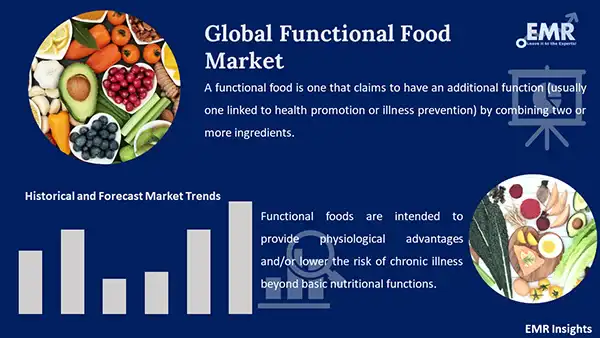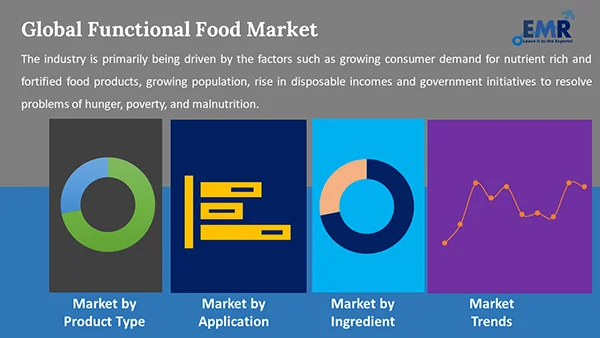
Consumer Insights
Uncover trends and behaviors shaping consumer choices today
Procurement Insights
Optimize your sourcing strategy with key market data
Industry Stats
Stay ahead with the latest trends and market analysis.
The global functional food market attained a value of USD 220.60 Billion in 2025 driven by rising emphasis on a healthier lifestyle across the globe. The market is further expected to grow at a CAGR of 6.70% in the forecast period of 2026-2035 and reach a value of USD 421.94 Billion by 2035.
Base Year
Historical Period
Forecast Period
The market is significantly driven by the rapidly evolving lifestyles of individuals, especially working people with no time to take care of their nutritional intake.
The ground-breaking product launches backed by extensive research by the companies are gaining traction in the market.
The increasing awareness of a healthy lifestyle and alternatives to address existing nutritional deficiencies is expected to increase the demand for functional foods in the forecast period.
Compound Annual Growth Rate
6.7%
Value in USD Billion
2026-2035
*this image is indicative*
A functional food combines two or more ingredients, claiming to have additional functions like preventing illness or boosting the overall health of an individual. Functional foods are intended to provide physiological advantages and/or lower the risk of chronic illness beyond basic nutritional functions. It can be taken as part of a normal diet and may look like traditional food.

Read more about this report - REQUEST FREE SAMPLE COPY IN PDF
Innovative Product Launches by Companies to Boost Market Growth
The market growth is significantly driven by innovative product launches by affluent companies, leading to increased demand for more innovative launches. For instance, in September 2024, ZBiotics, a biotechnology company specialising in genetically engineered probiotics, introduced its latest innovation, the Sugar-to-Fiber Probiotic Drink Mix. This groundbreaking product has been developed by a team of PhD microbiologists to address the lack of fiber in the average American diet. It is the first of its kind functional food product available to consumers in the United States. The product works by converting dietary sugar (sucrose) into a prebiotic fiber called levan, which works continuously to promote better gut health all day long. The product launch is aimed at filling the crucial gap by addressing fiber insufficiency in an average American diet. ZBiotics took benefit from genetic engineering to fill this gap, offering a more advanced solution to consumers.
Additionally, in August 2024, ZBiotics received USD 12 million in funding, which is expected to play a pivotal role in improving the company’s operations to address increasing consumer demand, enhance market presence, foster research and development activities to develop and bring ground-breaking innovations to the market, thereby, propelling development.
Increasing Attention to Adopt a Healthier Lifestyle to Boost Functional Food Market Demand
The market is expanding due to the rising consumer demand for nutritious and fortified food products. Functional ingredients like omega-3 and probiotics are widely utilised in fish oils and yoghurt to lower the risk of cardiovascular diseases and enhance the quality of intestinal microflora. This is driving the growth of the market. Furthermore, as people become more health-conscious and pay more attention to their lifestyles and diets, the demand for functional foods is expected to increase throughout the world. With the growing popularity of low-carbohydrate and high-protein diets such as paleo diets and the increasing awareness of digestive health, the market is anticipated to witness significant growth in the forecast period.
The market is witnessing several trends and developments to improve the current scenario. Some of the notable trends are as follows:

Read more about this report - REQUEST FREE SAMPLE COPY IN PDF
“Functional Food Market Report and Forecast 2026-2035” offers a detailed analysis of the market based on the following segments:
Market Breakup by Ingredient
Market Breakup by Product Type
Market Breakup by Application
Market Breakup by Region
Probiotics Leads the Market Segmentation by Ingredients
The segmentation by ingredient includes probiotics, minerals, proteins and amino acids, dietary fibers, vitamins, and others. Based on the segmentation, the prebiotics and dietary fibres segment is expected to grow at a rapid pace over the forecast period. Fibre consumption is linked to a variety of health advantages, including gut health maintenance, cholesterol reduction, and blood sugar control, to name a few. These benefits, together with the growing functional food industry, are projected to drive the dietary fibre segment forward. Moreover, prebiotics provide a variety of health advantages in the large intestine, including reduced cancer risk and improved calcium and magnesium absorption. Prebiotics are found in a variety of vegetables and fruits.
Based on the region, the market report offers insights into North America, Europe, Asia Pacific, Latin America, and the Middle East and Africa. The regional market share is significantly dominated by the Asia Pacific. The dominance is characterised by several factors such as the increasing awareness about the benefits of functional foods among individuals. The region is well-known for its traditional practices for possessing a healthy lifestyle including food intake. However, the rising influence of Western culture is affecting the younger generation in the region and leading to increased demand for functional food alternatives, propelling market growth.
With the rising adoption of sedentary lifestyles, the market is witnessing a growing interest in functional food that addresses chronic conditions like diabetes, cardiovascular diseases, and obesity. Another factor responsible for market growth in the region is the rising disposable incomes. With more disposable income, consumers are prioritising long-term health and adopting preventative healthcare approaches. This behaviour has led to a growing demand for functional foods that support specific health concerns such as immunity, digestive health, and weight management.
The key features of the market report comprise patent analysis, funding and investment analysis, and strategic initiatives by the leading players. The major companies in the market are as follows:
Established in 1919 and headquartered in Paris, France, Danone is a global leader in dairy, plant-based, and health-focused food products. Their portfolio includes probiotics, infant nutrition, and specialised health products, reflecting a commitment to health and wellness through their functional food lines.
Founded in 1997 and based in Kilkenny, Ireland, Glanbia is renowned for its dairy and nutritional products. It focuses on sports nutrition, protein supplements, and functional beverages, targeting health-conscious consumers with innovative solutions to support fitness and overall well-being.
Established in 2009 and headquartered in Downers Grove, Illinois, USA, Hearthside Food Solutions is a premier contract manufacturer of functional bars, snacks, and baked goods. Their offerings include protein bars, nutritional snacks, and other functional foods tailored to meet health and wellness trends.
Founded in 1911 with headquarters in McLean, Virginia, USA, Mars is best known for its confectionery and pet care products. The company has ventured into functional foods with nutrition-focused products, particularly through its subsidiary, Mars Edge, which offers supplements and specialized health products.
Established in 2009 and headquartered in Tokyo, Japan, Meiji Holdings specialises in dairy products, confectionery, and nutritional products. Their functional food portfolio includes probiotics, infant formula, and fortified foods, aimed at promoting health and addressing specific dietary needs.
*Please note that this is only a partial list; the complete list of key players is available in the full report. Additionally, the list of key players can be customized to better suit your needs.*
Other key players in the market include Nestlé S.A., Raisio plc, Royal FrieslandCampina N.V., Sanitarium Health Food Company, and The Kraft Heinz Company.
United States Functional Food Market
Asia Pacific Functional Food Market




*While we strive to always give you current and accurate information, the numbers depicted on the website are indicative and may differ from the actual numbers in the main report. At Expert Market Research, we aim to bring you the latest insights and trends in the market. Using our analyses and forecasts, stakeholders can understand the market dynamics, navigate challenges, and capitalize on opportunities to make data-driven strategic decisions.*
Get in touch with us for a customized solution tailored to your unique requirements and save upto 35%!
Explore our key highlights of the report and gain a concise overview of key findings, trends, and actionable insights that will empower your strategic decisions.
| REPORT FEATURES | DETAILS |
| Base Year | 2025 |
| Historical Period | 2019-2025 |
| Forecast Period | 2026-2035 |
| Scope of the Report |
Historical and Forecast Trends, Industry Drivers and Constraints, Historical and Forecast Market Analysis by Segment:
|
| Breakup by Ingredient |
|
| Breakup by Product Type |
|
| Breakup by Application |
|
| Breakup by Region |
|
| Market Dynamics |
|
| Supplier Landscape |
|
| Companies Covered |
|
Datasheet
One User
USD 3,299
USD 2,969
tax inclusive*
Single User License
One User
USD 5,499
USD 4,949
tax inclusive*
Five User License
Five User
USD 6,999
USD 5,949
tax inclusive*
Corporate License
Unlimited Users
USD 8,199
USD 6,969
tax inclusive*
*Please note that the prices mentioned below are starting prices for each bundle type. Kindly contact our team for further details.*
Flash Bundle
Small Business Bundle
Growth Bundle
Enterprise Bundle
*Please note that the prices mentioned below are starting prices for each bundle type. Kindly contact our team for further details.*
Flash Bundle
Number of Reports: 3
20%
tax inclusive*
Small Business Bundle
Number of Reports: 5
25%
tax inclusive*
Growth Bundle
Number of Reports: 8
30%
tax inclusive*
Enterprise Bundle
Number of Reports: 10
35%
tax inclusive*
How To Order

Select License Type
Choose the right license for your needs and access rights.

Click on ‘Buy Now’
Add the report to your cart with one click and proceed to register.

Select Mode of Payment
Choose a payment option for a secure checkout. You will be redirected accordingly.
Gain insights to stay ahead and seize opportunities.

Get insights & trends for a competitive edge.

Track prices with detailed trend reports.

Analyse trade data for supply chain insights.

Leverage cost reports for smart savings

Enhance supply chain with partnerships.

Connect For More Information
Our expert team of analysts will offer full support and resolve any queries regarding the report, before and after the purchase.
Our expert team of analysts will offer full support and resolve any queries regarding the report, before and after the purchase.
We employ meticulous research methods, blending advanced analytics and expert insights to deliver accurate, actionable industry intelligence, staying ahead of competitors.
Our skilled analysts offer unparalleled competitive advantage with detailed insights on current and emerging markets, ensuring your strategic edge.
We offer an in-depth yet simplified presentation of industry insights and analysis to meet your specific requirements effectively.
Share